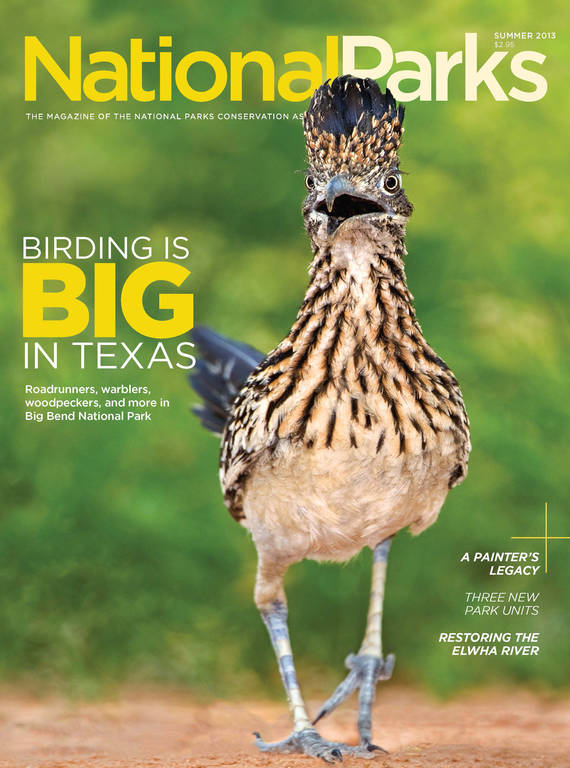Summer 2013
Shifting Tides
Once nearly extinct, sea otters have staged a remarkable comeback, but some coastal parks still struggle to retain these curious, sensitive mammals.
Otters’ lustrous fur—the thickest on the planet—keeps them alive in frigid Pacific waters, but two centuries ago it nearly caused their demise. The average otter sprouts up to a million hairs per square inch (compared with about 1,000 hairs on top of your head). That thick coat proved too tempting to hundreds of thousands of people who endured cold winters in the 1700s. In the middle of the century, Russian, American, and British ships started decimating otter populations to satiate a trendy demand for their fur, which sold for an enticing sum in Europe, China, and the United States.
Before the fur trade exploded, scientists estimate, as many as 300,000 sea otters roamed northern Pacific shores, from Japan and Russia to Alaska and Baja California. By the turn of the 20th century, only 11 isolated colonies, amounting to approximately 1,000 otters, remained in the Pacific. In 1911, the United States, Japan, Russia, and Great Britain signed a treaty outlawing the sale of otter pelts to protect the remaining otters.
The Hail Mary pass worked. Since then, sea otters have recovered in fits and starts but largely with success. They now number about 100,000 across the Pacific. Though they are still threatened in certain areas—California and the Aleutian Islands, for example—there is one particularly bright spot and intriguing success story: Glacier Bay National Park & Preserve in Alaska.
SPOT A SEA OTTER
A 3.3-million-acre enclave of rainforests, glaciers, and fjords, the park unwittingly became an otter mecca over the last 20 years. Since scientists first spotted them in 1995, Glacier Bay’s sea otter population has skyrocketed by an average of 42 percent each year. In 2012, the tally reached about 8,500 individuals. It is one of the fastest proliferations of sea otters and one of the highest population densities recorded.
“It was really exciting to watch,” says Jim Bodkin, a recently retired sea otter biologist for the U.S. Geological Survey (USGS), who studied the population. “One hundred years ago, there were probably only a few hundred sea otters [in the world].”
Clean water, a smorgasbord of food—clams, crabs, mussels, and urchins—and a ban on otter hunting and most commercial fishing in the park have contributed to the burgeoning population, but scientists still don’t know exactly why so many otters have migrated and reproduced here as opposed to other pristine areas of Alaska.
One thing is certain: Glacier Bay’s otter population has offered researchers an opportunity to better understand the keystone species’ dramatic effect on their environment. This year, scientists are wrapping up a landmark study of sea otters in Glacier Bay that was initiated by Bodkin and spanned nearly 20 years, three agencies, and more than 60 researchers.
The study tracked the otters’ population explosion in Glacier Bay and their effects on the nearshore environment, a soft, mucky sea floor that is common through southeast Alaska, the Pacific Northwest, and San Francisco Bay (compared with bedrock environments found elsewhere). Researchers found that otters eat like gluttons, which causes a drastic change in the underwater landscape. The effects of foraging within these habitats are yet to be determined, but the results of this study, to be published this year, could help biologists in other parks understand and manage the species in the years to come.
“For a scientist doing observational work, otters are a dream come true. They dive down and bring what they’re eating to the surface and kind of wave it around for you,” says Ben Weitzman, a sea-otter biologist with the USGS. “When you watch what they’re bringing up, you’re not just watching them; they’re a window into what’s happening under the surface.”
Historically, sea otters frequented a host of future national park sites, including the Channel Islands, Golden Gate, Point Reyes, Redwood, and Olympic, and half a dozen parks in Alaska. Now, healthy populations of otters reside in northwestern parks including Glacier Bay, Katmai, Kenai Fjords, and Olympic, but the species is spotted only intermittently in coastal California parks.
Scientists don’t know exactly why this playful, inquisitive species hasn’t fully recovered in California, but it may be that otters still have a lot of bullets to dodge. Great white sharks, other natural predators, disease, and a host of other factors may be contributing to the lack of recovery. And, because they consume large numbers of grazers and lick their fur, toxins and pollutants in the water, such as PCBs, quickly accumulate in their bodies.

National Parks
You can read this and other stories about history, nature, culture, art, conservation, travel, science and more in National Parks magazine. Your tax-deductible membership donation of $25 or more entitles…
See more ›One of the biggest problems for otters is that they like to eat the same things we do. Male otters generally weigh about 65 pounds (females weigh about 45) but can eat up to a third of their body weight each day. This can spur conflicts with commercial and subsistence fishermen and urchin divers in parts of Alaska and California where otters are particularly abundant.
The U.S. Fish and Wildlife Service had been trying to minimize those conflicts by capturing and transporting otters found in fishing areas, including the waters south of Point Conception, California, but that practice proved unsuccessful so it was ended. The agency also abandoned an unsuccessful relocation program that brought otters from Monterey to San Nicolas Island in the late ’80s and early ’90s. Now that otters are allowed to roam freely, colonize, and expand their numbers in California, park managers believe that it’s only a matter of time before they return to the state’s national parks. And when they do, observations from Glacier Bay could come in handy.
“It could be 20 years before we have established breeding populations at our northern islands,” says Kate Faulkner, chief of natural resources management for Channel Islands National Park. “We know that they will return eventually, but we’ll just have to wait and see.”
About the author
-
 Kate Siber Contributor
Kate Siber ContributorKate Siber, a freelance writer and correspondent for Outside magazine, is based in Durango, Colorado. Her writing has appeared in National Geographic Traveler and The New York Times. She is also the author of “National Parks of the U.S.A.,” a best-selling children’s book.



